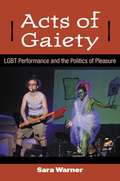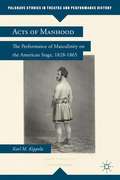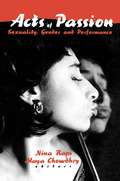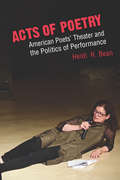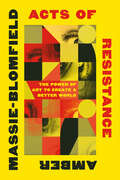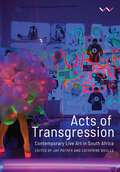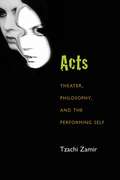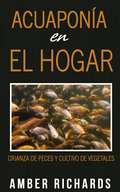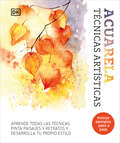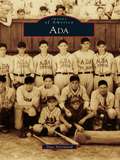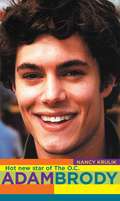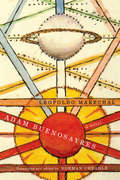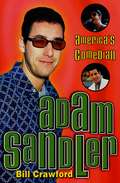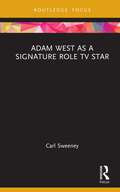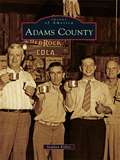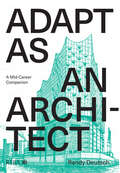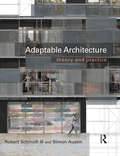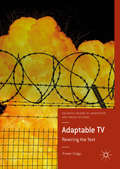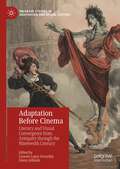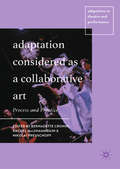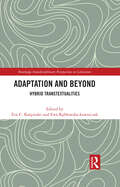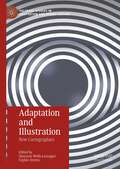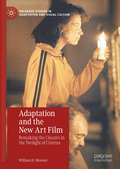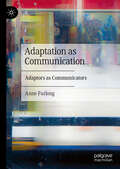- Table View
- List View
Acts of Gaiety: LGBT Performance and the Politics of Pleasure
by Sara WarnerActs of Gaiety explores the mirthful modes of political performance by LGBT artists, activists, and collectives that have inspired and sustained deadly serious struggles for revolutionary change. The book explores antics such as camp, kitsch, drag, guerrilla theater, zap actions, rallies, manifestos, pageants, and parades alongside more familiar forms of "legitimate theater. " Against queer theory's long-suffering romance with mourning and melancholia and a national agenda that urges homosexuals to renounce pleasure if they want to be taken seriously by mainstream society, Acts of Gaiety seeks to reanimate notions of "gaiety" as a political value for LGBT activism. The book mines the archives of lesbian-feminist activism of the 1960s-70s, highlighting the outrageous gaiety that lay at the center of the social and theatrical performances of the era and uncovering original documents long thought to be lost. Juxtaposing historical figures such as Valerie Solanas and Jill Johnston with more recent performers and activists (including Hothead Paisan, Bitch & Animal, and the Five Lesbian Brothers), Warner shows how reclaiming this largely discarded and disavowed past elucidates possibilities for being and belonging. Acts of Gaiety explores the mutually informing histories of gayness as politics and as joie de vivre, along with the centrality of liveliness to queer performance and protest.
Acts of Manhood
by Karl M. KippolaExploring the performance of masculinity on and off the nineteenth-century American stage, this book looks at the shift from the passionate muscularity to intellectual restraint as not a linear journey toward national refinement; but a multitude of masculinities fighting simultaneously for dominance and recognition.
Acts of Passion: Sexuality, Gender, and Performance
by Nina Rapi Maya ChowdhryThe first volume to focus exclusively on lesbian performance work, Acts of Passion: Sexuality, Gender, and Performance draws on the experiences and expertise of a wide range of lesbian practitioners and theorists to explore the impact and influences of sexuality and gender on performance. It examines essays, dialogues, and performance texts from theater directors, performers, theorists, playwrights, and performance writers against social and cultural constructs and performance theories to produce a diverse and challenging portrait of lesbian live performance art. The book’s penetrating scope covers drag queens, lesbian vampires, representations of lesbian sex, solo artists, the art of collaboration, lesbian aesthetics, and lesbian playwrights writing straight and illustrates why live performance is one of the most dynamic forums in which women can create, control, and produce their work without artistic constraint.Acts of Passion explodes binary definitions of gender and sexuality by destabilizing familiar notions of the ‘real’and creating new production values and aesthetics in the process. The relationships between experience and expression, sexuality and cultural placing, context and artistic control, representation and self-representation become clearer as the book discusses: the manner in which women are represented as absent in the signifying system of patriarchal society how questions of purity, ‘authenticity,’and self-definition complicate the field of representation the power of lesbian dance performance to make the lesbian body culturally visible several ‘new wave’performers--creating work, getting seen, showing flesh, doing politics, and making money the projections, preconceptions, expectations, and general baggage attached to the performing lesbian body what the term ‘lesbian playwright’means within contemporary culture ‘It’s Queer Up North’--a British National Arts Organization the arguments for and against mainstreaming lesbian performanceAnyone interested in theater and performance, cultural studies, gender issues, and the politics of ‘positive representation’--whether playwright, performer, director, writer, academic, student, or theatre goer--will find Acts of Passion a powerful step in wrenching the power of representation away from the dominant culture. Defiant, saucy, sexy, and smart, the contributors appropriate their own spaces, identities, crafts, and languages, both within this book and without.
Acts of Poetry: American Poets' Theater and the Politics of Performance
by Heidi R BeanAmerican poets’ theater emerged in the postwar period alongside the rich, performance-oriented poetry and theater scenes that proliferated on the makeshift stages of urban coffee houses, shared apartments, and underground theaters, yet its significance has been largely overlooked by critics. Acts of Poetry shines a spotlight on poets’ theater’s key groups, practitioners, influencers, and inheritors, such as the Poets’ Theatre, the Living Theatre, Gertrude Stein, Bunny Lang, Frank O’Hara, Amiri Baraka, Carla Harryman, and Suzan-Lori Parks. Heidi R. Bean demonstrates the importance of poets’ theater in the development of twentieth-century theater and performance poetry, and especially evolving notions of the audience’s role in performance, and in narratives of the relationship between performance and everyday life. Drawing on an extensive archive of scripts, production materials, personal correspondence, theater records, interviews, manifestoes, editorials, and reviews, the book captures critical assessments and behind-the-scenes discussions that enrich our understanding of the intertwined histories of American theater and American poetry in the twentieth century.
Acts of Resistance: The Power of Art to Create a Better World
by Amber Massie-BlomfieldWhat is the purpose of art in a world on fire? Can it be a genuine form of political resistance? What is the purpose of art in a world on fire? In this exhilarating and deeply inspiring work, Amber Massie-Blomfield considers the work of artists, writers, musicians, and filmmakers—such as Gran Fury, Billie Holiday, Alexis Wright, Claude Cahun, Rick Lowe, and Joseph Beuys—alongside collectives, communities, and organizations that have used protest sites as their canvas and spearheaded political movements. From writer Ken Saro Wiwa combatting oil pollution in Nigeria and Susan Sontag directing Waiting for Godot in besieged Sarajevo to the women stitching subversive patchworks in Pinochet’s Chile and the artist-activists who blocked the building of a new airport in France, with stories drawn from environmentalism, feminism, anti-fascism, and other movements, Acts of Resistance brings together remarkable acts of creativity that have shifted history on its axis.
Acts of Transgression: Contemporary Live Art in South Africa
by Catherine BoulleFifteen writers explore the experimental, interdisciplinary and radically transgressive field of contemporary live art in South Africa, focusing on a wide range of perspectives, personalities and theoretical concerns Contemporary South African society is chronologically ‘post’ apartheid, but it continues to grapple with material redress, land redistribution and systemic racism. Acts of Transgression represents the complexity of this moment in the rich potential of a performative art form that transcends disciplinary boundaries and aesthetic conventions. The contributors, who are all significantly involved in the discipline of performance art, probe its intersection with crisis and socio-political turbulence, shifting notions of identity and belonging, embodied trauma and loss. Narratives of the past and visions for the future are interrogated through memory and the archive, thus destabilising entrenched colonial systems.Collectively analysing the work of more than 25 contemporary South African artists, including Athi-Patra Ruga, Mohau Modisakeng, Steven Cohen, Dean Hutton, Mikhael Subotzsky, Tracey Rose and Donna Kukama, among others, the analysis is accompanied by a visual record of more than 50 photographs. For those working in the fields of theatre, performance studies and art, this is a must-have collection of critical essays on a burgeoning and exciting field of contemporary South African research.
Acts: Theater, Philosophy, And The Performing Self
by Tzachi ZamirWhy do people act? Why are other people drawn to watch them? How is acting as a performing art related to role-playing outside the theater? As the first philosophical study devoted to acting, Acts: Theater, Philosophy, and the Performing Self sheds light on some of the more evasive aspects of the acting experience— such as the import of the actor's voice, the ethical unease sometimes felt while embodying particular sequences, and the meaning of inspiration. Tzachi Zamir explores acting’s relationship to everyday role-playing through a surprising range of examples of “lived acting,” including pornography, masochism, and eating disorders. By unearthing the deeper mobilizing structures that underlie dissimilar forms of staged and non-staged role-playing, Acts offers a multi-layered meditation on the percolation from acting to life. The book engages questions of theatrical inspiration, the actor’s “energy,” the difference between acting and pretending, the special role of repetition as part of live acting, the audience and its attraction to acting, and the unique significance of the actor’s voice. It examines the embodied nature of the actor’s animation of a fiction, the breakdown of the distinction between what one acts and who one is, and the transition from what one performs into who one is, creating an interdisciplinary meditation on the relationship between life and acting.
Acuaponía en el hogar
by Amber Richards Gloria Cifuentes Dowling¿Se ha preguntado alguna vez de qué se trata la acuaponía? ¿Se adapta a su estilo de vida? Este libro representa una buena alternativa para ayudarle a responder estas y otras interrogantes. La acuaponía es una innovadora ciencia por medio de la cual las plantas crecen en agua en lugar de hacerlo en tierra. En esa misma agua también se crían peces. Los desechos producidos por ellos y por otros animales acuáticos proporcionan los nutrientes que requieren las plantas y estas, en retribución, purifican el agua donde viven los peces. Cuando la acuaponía se implementa de manera correcta puede resultar autosustentable y representar un ambiente saludable para peces y plantas. "Acuaponía en el hogar" es una guía para el principiante que desee incursionar en este pasatiempo. Le proporcionará las bases para montar este maravilloso y apasionante sistema de cultivo, indicándole los componentes que se requieren y los métodos para la implementación de su propio sistema acuapónico saludable que le brindará alimento seguro, fresco y delicioso durante todo el año. Descargue ahora su ejemplar.
Acuarela (Artist's Watercolor Techniques): Técnicas artisticas
by DKKickstart your creativity and make a masterpiece with step-by-step workshops and advice from professional artists. Whether you’re just starting out with watercolor painting or want to expand your skills and raise your art to the next level, this book has all the inspiration and practical know-how you'll need.Starting from the basics, such as choosing the right brushes and practicing color mixes, the book tackles every conceivable watercolor technique - from applying a flat wash to experimenting with texture. Techniques and inspiration are then combined in a wide-ranging section on subject matter - from landscapes to botanical illustration, urban scenes, portraiture, and abstraction - which examines the practical considerations of each topic and showcases numerous different approaches to try, with tutorials on achieving particular effects.Here's what you'll find inside the pages of this guide:Includes over 80 detailed step-by-step workshops for pencil, charcoal, pen, and pastel techniques.A range of techniques suits beginners or more experienced artists.Techniques are approached with progression in mind so readers can learn the basics and move on to new creative challenges.Artist's Watercolour Techniques will help you tap into your creative potential and unlock new talents, whether you are a beginner or a seasoned artist. This is the ultimate watercolor painting course to help you take your sketches to a higher level. Each technique and stylistic approach is demonstrated by a professional artist working on an original painting, photographed at different stages of development to give rare insights into the artistic process.---------------------------Pon en marcha tu creatividad y crea una obra maestra con ejercicios paso a paso y consejos de artistas profesionales.Tanto si estás comenzando a pintar con acuarela como si deseas mejorar tus habilidades y llevar tu arte al siguiente nivel, gracias a Acuarela Técnicas Artísticas podrás desarrollar tu talento y crecer como artista.Este completo libro de pintura aborda todo lo necesario para iniciarte en el arte de la acuarela: desde lo básico como elegir los pinceles adecuados y mezclar colores, hasta técnicas de acuarela populares y avanzadas como la pincelada plana, el mojado en seco o cómo experimentar con texturas.En el interior de esta completa guía paso a paso para pintar acuarela encontrarás:Más de 80 ejercicios para aprender los principios de composición y dominar diferentes técnicas, como el lavado en plano.Instrucciones detalladas e imágenes con explicaciones paso a paso.Amplia selección de temas: desde paisajes, escenas urbanas, retratos, dibujos abstractos y mucho más.Consejos de artistas profesionales y proyectos inspiradores para que pongas a prueba lo aprendido desde casa.Acuarela: técnicas artísticas es el mejor libro para aprender a pintar. Te ayudará a exprimir tu potencial creativo y desbloquear nuevos talentos, ya seas un artista principiante o todo un experto. Este es el curso de acuarela definitivo para ayudarte a que tus bocetos cobren vida.¡Domina todas las técnicas de la pintura con acuarela y crece como artista!
Acupressure for Horses
by Ina GosmeierHelp your horse with simple acupressure techniques:Learn to identify your horse's individual body constitution type, which determines choices of acupressure treatmentUnderstand the 12 main channels of energy in your horse's bodyGain the ability to choose the correct points to treat specific issuesRelieve mild sources of pain and discomfort in your horse's bodyInfluence his mental health and stabilityChoose appropriate treatment from a comprehensive list of common problemsUse step-by-step instructions and photos to help your horse
Ada
by Dare StricklandAda, named after the eldest daughter of Jeff Reed, a founder of the town, is located in the east central part of Oklahoma. It is the county seat of Pontotoc County and was called the worst town for criminal activity in the Indian Territory for the lack of justice. The west end block of Main Street was called the "Bucket of Blood" and harbored many murderers and outlaws until, in 1909, the hanging of four men in a stable advised all who would hide in Ada to leave or suffer the same fate. The murder of former U.S. marshal Gus Bobbitt was the catalyst for this desperate action. The hanging is one of the most talked about tales of the early West. Growing from the oil, cotton, and cement industries, Ada is known as the city of clear spring water. The Chickasaw Nation has its headquarters in Ada and has been a fount of industry and beauty in the town.
Adam Buenosayres: A Novel
by Leopoldo MarechalA modernist urban novel in the tradition of James Joyce, Adam Buenosayres is a tour-de-force that does for Buenos Aires what Carlos Fuentes did for Mexico City or José Lezama Lima did for Havana - chronicles a city teeming with life in all its clever and crass, rude and intelligent forms. Employing a range of literary styles and a variety of voices, Leopoldo Marechal parodies and celebrates Argentina's most brilliant literary and artistic generation, the martinfierristas of the 1920s, among them Jorge Luis Borges. First published in 1948 during the polarizing reign of Juan Perón, the novel was hailed by Julio Cortázar as an extraordinary event in twentieth-century Argentine literature. Set over the course of three break-neck days, Adam Buenosayres follows the protagonist through an apparent metaphysical awakening, a battle for his soul fought by angels and demons, and a descent through a place resembling a comic version of Dante's hell. Presenting both a breathtaking translation and thorough explanatory notes, Norman Cheadle captures the limitless language of Marechal's original and guides the reader along an unmatched journey through the culture of Buenos Aires. This first-ever English translation brings to light Marechal's masterwork with an introduction outlining the novel's importance in various contexts - Argentine, Latin American, and world literature - and with notes illuminating its literary, cultural, and historical references. A salient feature of the Argentine canon, Adam Buenosayres is both a path-breaking novel and a key text for understanding Argentina's cultural and political history.
Adam Sandler
by Bill CrawfordFrom the comedy clubs of New York to his big break on "Saturday Night Live" to block-buster films like "Big Daddy" and "Little Nicky" Adam Sandler has left America howling in their seats and peeing in their pants. Sandler has emerged as the decade's most unstoppable comedic-and the ladies love him! But how many people know the story behind this lovable comedic prodigy's ascent to fame? Bill Crawford takes you back to Sandler's childhood in a small New Hampshire Town, where his stand-up routines were always hits with his classmates but not necessarily the teachers! When Adam left his small town to take on the big city at New York University, it wasn't always easy, Sandler performed as a street musician crooning Springsteen songs to commuters, but he was destined to succeed. From his long friendship with then college classmate Tim Herlihy, who went on to co-write all Sandler's movies, to being discovered by Dennis Miller and eventually becoming America's funnyman, Bill Crawford looks behind the headlines and tabloid tales to shed new light on this decade's comedic darling.
Adam West as a Signature Role TV Star (Routledge Focus on Television Studies)
by Carl SweeneyThis book proposes the ‘signature role TV star’ as a new theoretical category of stardom by evaluating Adam West as a quintessential example of this type of figure.West was best known for playing the titular role in the 1960s television series Batman. After Batman was cancelled, West was unable to develop a lasting career as a mainstream leading man, meaning that his signature role remained the defining aspect of his public image. In various ways, West demonstrated that the strong link with a signature televisual role can generate new inflections over time, meaning that he embodies both the advantages and disadvantages of this form of stardom. The analysis of West as an archetypal signature role TV star is accomplished within a star studies theoretical framework that focuses on his onscreen roles, his promotional and publicity appearances and criticism and commentary materials about him. The signature role TV star category proposed in this book can be utilised to illuminate the significance of other television stars who have been overlooked by scholars.This book will have relevance for undergraduate and postgraduate students of Film Studies, Television Studies, Media and Communication Studies, Cultural Studies, Visual Studies and Comics Studies.
Adams County
by Stephen KelleyAdams County was established on July 10, 1797. Carved out of the Old Northwest, it is the third-oldest county in Ohio, predating the state by more than five years. The county's southern boundary is the Ohio River, once a vital component in the commerce and growth of the county. When the first explorers and settlers came here, prehistoric earthworks dotted the landscape. The most significant, the Great Serpent Mound, is preserved today in a public park. In antebellum days, the county was a hotbed of abolitionist activities with several "stations" organized on the Underground Railroad. During the Civil War, Confederate General John H. Morgan and his raiders passed through the county taking horses, food, and anything they liked. The vintage views in this book that help tell the story of the county come from the collections of the Adams County Historical Society, the Adams County Genealogical Society, and several private sources.
Adapt As An Architect: A Mid-Career Companion
by Randy DeutschAdapt As An Architect: A Mid-Career Companion is the only book that helps design professionals to navigate the vast heart of the architect’s journey. It serves as a roadmap: a career GPS that provides options for architects getting from where they are today to where they really want to be. The focus of this optimistic, engaging book is on continued relevance, professional engagement, perseverance, and career longevity. It argues that mid-career is the lynchpin of the architect’s career, and provides the guidance and support that practices themselves are missing for emerging professionals, who are often left to their own devices to find their way as they approach the middle of their career. This book means architects don’t need to navigate these years on their own.
Adaptable Architecture: Theory and practice
by Robert Schmidt III Simon AustinAdaptable Architecture provides thought-provoking and inquisitive insights into how we can prolong the useful life of buildings by designing them to be more adaptable, and hence create a more sustainable built environment. The book provides a theoretical foundation counterpointed by the experiences and ideas of those involved in the design and use of buildings. It explains many approaches to designing for change, with lessons from history, and case studies including The Cedar Rapids Public Library, Kentish Town Health Centre and Folkestone Performing Arts Centre, which stretch our thinking beyond the conventional notions of adaptability. The authors reveal the many conditions that make it a complex design phenomenon, by considering the purpose, design and business case of buildings as well as the physical product. Full of summaries, diagrams, reference charts, tables, and photos of exemplar solutions for use as conversational tools or working aids, this book is for any professional or student who wants to research, question, imagine, illustrate - and ultimately design for - adaptation. In addition, further information and resources are available through the Adaptable Futures website www.adaptablefutures.com which includes additional case studies, videos, information about industry events and up-to-the-minute developments.
Adaptable TV: Rewiring The Text (Palgrave Studies In Adaptation And Visual Culture Series)
by Yvonne GriggsThis book focuses on the significantly under-explored relationship between televisual culture and adaptation studies in what is now commonly regarded as the ‘Golden Age’ of contemporary TV drama. Adaptable TV: Rewiring the Text does not simply concentrate on traditional types of adaptation, such as reboots, remakes and sequels, but broadens the scope of enquiry to examine a diverse range of experimental adaptive types that are emerging within an ever-changing TV landscape. With a particular focus on the serial narrative form, and with case studies that include Penny Dreadful, Fargo, The Night Of and Orange is the New Black, this study is essential reading for anyone who is interested in the complex interplay between television studies and adaptation studies.
Adaptation Before Cinema: Literary and Visual Convergence from Antiquity through the Nineteenth Century (Palgrave Studies in Adaptation and Visual Culture)
by Lissette Lopez Szwydky Glenn JellenikAdaptation Before Cinema highlights a range of pre-cinematic media forms, including theater, novelization, painting and illustration, transmedia art, children’s media, and other literary and visual culture. The book expands the primary scholarly audience of adaptation studies from film and media scholars to literary scholars and cultural critics working across a range of historical periods, genres, forms, and media. In doing so, it underscores the creative diversity of cultural adaptation practiced before cinema came to dominate the critical conversation on adaptation. Collectively, the chapters construct critical bridges between literary history and contemporary media studies, foregrounding diverse practices of adaptation and providing a platform for innovative critical approaches to adaptation, appropriation, or transmedia storytelling popular from the Middle Ages through the invention of cinema. At the same time, they illustrate how these forms of adaptation not only influenced the cinematic adaptation industry of the twentieth century but also continue to inform adaptation practices in the twenty-first century transmedia landscape. Written by scholars with expertise in historical, literary, and cultural scholarship ranging from the medieval period through the nineteenth century, the chapters use discourses developed in contemporary adaptation studies to shed new lights on their respective historical fields, authors, and art forms.
Adaptation Considered as a Collaborative Art: Process and Practice (Adaptation in Theatre and Performance)
by Bernadette Cronin Rachel MagShamhráin Nikolai PreuschoffThis book examines the processes of adaptation across a number of intriguing case studies and media. Turning its attention from the 'what' to the 'how' of adaptation, it serves to re-situate the discourse of adaptation studies, moving away from the hypotheses that used to haunt it, such as fidelity, to questions of how texts, authors and other creative practitioners (always understood as a plurality) engage in dialogue with one another across cultures, media, languages, genders and time itself. With fifteen chapters across fields including fine art and theory, drama and theatre, and television, this interdisciplinary volume considers adaptation across the creative and performance arts, with a single focus on the collaborative.
Adaptation and Beyond: Hybrid Transtextualities (Routledge Interdisciplinary Perspectives on Literature)
by Eva C. Karpinski Ewa Kębłowska-ŁawniczakThis interdisciplinary collection focuses on recent adaptations, both experimental and popular, that put hybridity, transtextuality, and transmediality at play. It reframes adaptation in terms of the transmedia concept of "world-building," which accurately captures the complexity and multidirectionality of contemporary scattered and ubiquitous practices of adaptation. The Editors argue that the process of moving stories or their elements across different media platforms and repurposing them for new uses results in the production of hybrid transtextualities. The book demonstrate how hybrid textualities augment narrative and literary forms as goals of their world-building, finding unexpected sites of cross-pollination, expansion, and appropriation in spoken-word and dance performance, (auto)biographical comics, advertising, Chinese Kun opera, and popular song lyrics. This yoking of hybridity and transmediality yields not only diversified and often commercialized aesthetic forms but also enables the emergence a unique cultural space in-between, a mezzaterra capable of addressing current political issues and mobilizing broader audiences
Adaptation and Illustration: New Cartographies (Palgrave Studies in Adaptation and Visual Culture)
by Shannon Wells-Lassagne Sophie AymesThis collection examines the relationship between illustration and adaptation from an intermedial and transcultural perspective. It aims to foster a dialogue between two fields that co-exist without necessarily acknowledging advances in each other’s domains, providing an argument for defining illustration as a form of adaptation, as well as an intermedial practice that redefines what we mean by adaptation. The volume embraces both a specific and an extended definition of illustration that accounts for its inclusion among the web of adaptive practices that developed with the rise of new media and intermediality. The contributors explore how crossovers may contribute to reappraise their objects, and rely on a transmedial and interdisciplinary corpus exploring the boundaries between illustration and other media such as texts, graphic novels, comics, theatre, film and mobile applications. Arguably adaptation, like intermediality, is an umbrella term that covers a variety of practices and products, and both of them have been shaped by intense debates over their boundaries and internal definitions. Illustration belongs to each of these areas, and this volume proposes insight into how illustration not only relates to adaptation and intermediality but how each field is redefined, enriched and also challenged by such interactions.
Adaptation and the New Art Film: Remaking the Classics in the Twilight of Cinema (Palgrave Studies in Adaptation and Visual Culture)
by William H. MooneySince the 1990s, the expropriation of canonical works of cinema has been a fundamental dimension of art-film exploration. Rainer Werner Fassbinder provides an early model of open adaptation of film classics, followed ever more boldly by the Coen Brothers, Chantal Akerman, Alex Carax, Todd Haynes, Florian Henckel von Donnersmarck, Baz Luhrmann, and Olivier Assayas. This book devotes chapters to each of these directors to examine how their films redeploy landmark precursors such as City Lights (1931), Citizen Kane (1941), Rome Open City (1945), All About Eve (1950), and Vertigo (1958) in order to probe our psychological, philosophical, and historical situations in a postmodern société du spectacle. In broadly diverse ways, each of these directors complicates received notions of the past and its representation, while probing the transformative media evolution and dislocation of the present, in film art and in society.
Adaptation as Communication: Adaptors as Communicators
by Anne FurlongThis book offers a consistent, theoretically grounded, accessible account of adaptation across a range of instances, employing Relevance Theory as its explanatory framework and arguing that every adaptation is an independent communicative act. The author establishes the principles of the study in the first part, introducing and contextualising the theory developed by Sperber and Wilson, before going on in the second part to demonstrate the strength of the approach, and its relevance and utility within adaptation studies and beyond through a wide array of examples. The volume will open up discussion in areas previously underserved by adaptation studies and consider broader implications, such as where we draw the line when we think about 'adaptation'. This book will be of interest to students and scholars in a range of fields including adaptation studies, relevance theory, linguistic pragmatics, stylistics, narratology, intertextuality, literature and film studies.
